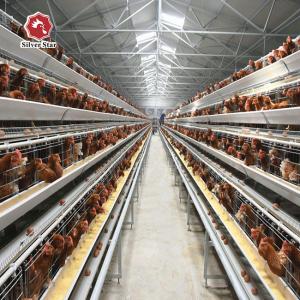

Add to Cart
Multi-Layer European Chicken Cages Laying System Farm Layer Battery Cages For Sale
management
The layer chicken cage
The production process of chicken is generally two-stage or
three-stage rearing. Two-stage rearing includes brood rearing
chickens (0~140 days old) and laying hens (141~532 days old). The
three stages of rearing included brooding (0 to 49 days of age),
rearing (50 to 140 days of age) and laying eggs (141 to 532 days of
age). Brood generally adopt brood umbrella flat brood, the inside
of the umbrella evenly distributed heating tube, to ensure the
environmental temperature needed by chicks. Complete sets of
equipment such as temperature and environment control can be used
in newly built farms with good conditions. The turnover process of
chicken flocks was 30 to 40 days, and incubation, breeding and
elimination were carried out successively.
What are the automatic laying hens breeding equipment?
In order to ensure the integrity of eggs and facilitate the
collection of eggs, adult laying hens are generally raised in
cages, which can be divided into two modes: stacked or stepped.
Stacking feeding method: from the stage of brooding to the stage of
adult chickens, generally four layers are stacked, each building is
set up about 10 groups, each building can raise 7500~8500 birds;
Stacking of chicken coops using large four-layer overlapping cages
or three-layer cages, four-layer cages are arranged in double row,
each building can hold 7000 chickens; Laying hens adopt large
two-storey full step laying cages, which are arranged in two whole
cages and two half cages in three parallel corridors. Each building
can hold about 5500 chickens. Natural lighting is the main
lighting, supplemented by artificial lighting. Generally,
artificial feeding, dung cleaning, egg picking, V-shaped water tank
water supply, cleaning once a day. The chicken houses are open
structure, adopt "long eaves, floor Windows, double rolling
curtains" to adjust the house environment under different climate
conditions. In terms of site layout and epidemic prevention, the
following measures have been taken:
1.1 Adjust measures to local conditions. The breeding area is
located in the tuyere below the living area and far from the water
source.
1.2 Clean and sewage channels shall be strictly separated, closed
drains shall be established, and regular disinfection and cleaning
shall be carried out to ensure their unobstructed flow.
1.3 Strictly control the circulation of vehicles and appliances in
the venue.
1.4 Strictly control external vehicles and personnel, and conduct
disinfection and isolation when entering and exiting.
1.5 The vehicles inside and outside the venue shall go their own
way and do not enter each other's venue.
1.6 There is a difference between the level of manure site and the
level of chicken house.
1.7 A ditch is set in the middle of the egg storehouse to prevent
the mixing of egg dishes inside and outside the egg storehouse
Increase egg production
Healthy chickens are more productive than those raised in unhealthy conditions, and enrichment cages increase the potential for egg production.
In fact, recent estimates suggest that 60 per cent of eggs used in products such as mayonnaise, sandwiches and cakes come from caged chickens. This suggests that chickens are more likely to lay eggs in cages than in other breeding methods, with the use of multi-layer cages preferred to aid egg production.
Product introduction
Henan silver star cage net introduction, 1250 type frame layer layer cage, scope of application: laying hens, breeding hens. Each cage net 650 mm long, 1250 mm wide, each cage net around a door, each door 650 mm long, 650 mm deep, 500 mm high. Large open space for maximum comfort, precise structural details to enhance welfare, up to 9 animals per door. The chicken has an area of 452 square centimeters. Each cage net feeding capacity of 18.
The breeding capacity of each compartment of three layers is 54. The breeding capacity of each enclosure is 72. The breeding capacity of each enclosure is 90. There are 108 birds in each enclosure of six floors. Four layers are the most common. Multilayer partition structure optional, duplex multilayer structure generally to take 4 plus 4 eight layers, or 3 plus 3 plus 3 nine layers. Reduce housing costs. Improve the overall value. To learn more about related products, matching related automatic equipment welcome to inquire
| 3-tiers | 0.65*1.25*2.65 m | 54 chickens |
| 4-tiers | 0.65*1.25*3.3 m | 72 chickens |
| 5-tiers | 0.65*1.25*4.6 m | 90 chickens |
| 6-tiers | 0.65*1.25*4.9 m | 108 chicekns |
| 7-tiers | 0.65*1.25*5.5 m | 126 chickens |
| 8-tiers | 0.65*1.25*6.2 m | 144 chickens |
| 9-tiers | 0.65*1.25*7.2 m | 162 chickens |
